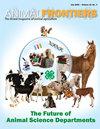抗生素会影响整个动物王国的微生物群和体重增加
IF 4.2
2区 农林科学
Q1 AGRICULTURE, DAIRY & ANIMAL SCIENCE
引用次数: 16
摘要
在发现抗生素并成功应用于治疗传染病后不久,研究人员发现亚治疗性抗生素治疗具有促进生长的能力(Jukes和Williams, 1953;泰勒和戈登,1955年;Dubos et al., 1963)。60多年来,亚治疗性抗生素治疗已被证明可以提高多种牲畜的生长速度和体重增加,包括鸡、猪、牛和羊,这表明微生物与宿主代谢之间存在进化上保守的关系。由于抗生素在最初发现时的成本很高(克伦威尔,2002年),抗生素在动物饲料中的含量很低。这种经济上受限制的剂量选择被证明是幸运的,因为后来的研究表明,大剂量抗生素治疗可能导致体重增加或减轻(Dubos等人,1963;Carvalho et al., 2012)。许多种类的抗生素对促进生长是有效的,包括那些用于治疗人类疾病并被FDA归类为对人类健康非常重要或至关重要的抗生素,如b-内酰胺类、大环内酯类、林科胺类和四环素类(Apley等,2012),尽管该类抗生素在人类和动物使用中可能有所不同(例如,阿奇霉素是一种用于人类的大环内酯类药物,而泰洛素是一种兽医用大环内酯类药物)。虽然许多抗生素在欧洲已经被禁止了几十年(Millet和Maertens, 2011),但它们的使用直到最近才在美国被逐步淘汰,以响应FDA对自愿退出的指导。用于促进生长的抗菌剂量通常比用于治疗的剂量低一到两个数量级(Apley等人,2012;Subbiah et al., 2016),其主要目的不是治疗疾病或预防感染(Allen and Stanton, 2014)。例如,用于促进生长的剂量为70毫克/头动物/天,用于预防感染的剂量为350毫克/头动物/天,对于300公斤重的牛,剂量为22毫克/头动物——约为6600毫克/头动物(Cazer等人,2014年)。使用低剂量抗生素促进生长的做法今天在世界各地仍在继续,预计在一些国家会增加(Van Boeckel等人,2015)。虽然它具有与增加体重和饲料效率(食物转化为动物质量)相关的经济效益,但不同生产设施的结果可能有所不同,而且越来越多的证据和担忧表明,广泛使用低剂量抗生素增加了对抗生素耐药细菌的选择及其向人类的传播(Allen et al., 2013)。近年来,有立法行动和消费者的压力,以减少或消除使用抗生素促进生长(Borron, 2012;抗生素会影响整个动物王国的微生物群和体重增加本文章由计算机程序翻译,如有差异,请以英文原文为准。
Antibiotics shape microbiota and weight gain across the animal kingdom
Shortly after the discovery of antibiotics and their successful application to treat infectious diseases, researchers discovered the growth-promoting capacity of sub-therapeutic antibiotic treatment (Jukes and Williams, 1953; Taylor and Gordon, 1955; Dubos et al., 1963). For more than 60 yr, sub-therapeutic antibiotic treatment has been shown to increase growth rate and weight gain in a wide variety of livestock, including chickens, pigs, cows, and sheep, indicating an evolutionarily conserved relationship between microbes and host metabolism. Because of the high cost of antibiotics at the time of initial discovery (Cromwell, 2002), antibiotics were provided low levels in the animal feed. This economically constrained dosage choice turned out to be a fortunate one, since later studies demonstrated that highdose antibiotic treatment could lead to reduced weight gain or weight loss (Dubos et al., 1963; Carvalho et al., 2012). Many classes of antibiotics are efficacious for growth promotion, including those used to treat human diseases and categorized by the FDA as highly important or critically important for human health, such as b-lactams, macrolides, lincosamides, and tetracyclines (Apley et al., 2012), although the specific antibiotic within the class may differ for human vs. animal use (e.g., azithromycin is a macrolide used for humans, and tylosin a veterinary macrolide). While many antibiotics have been banned in Europe for decades (Millet and Maertens, 2011), their use is only recently being phased out in the United States in response to FDA guidance for a voluntary withdrawal. The antimicrobial dose for growth promotion is often one to two orders of magnitude lower than for therapeutic applications (Apley et al., 2012; Subbiah et al., 2016) and does not have the primary goal of treating disease or preventing infection (Allen and Stanton, 2014). For example, chlortetracycline would be administered at 70 mg/animal/day for growth promotion, at 350 mg/animal/day to for prophylaxis against catching infection, and at 22 mg/kg body weight—approximately 6,600 mg/animal for a 300-kg steer (Cazer et al., 2014). The practice of using low-dose antibiotic growth promotion continues today around the world and is projected to increase in several countries (Van Boeckel et al., 2015). While it has economic benefits associated with increasing weight gain and feed efficiency (the conversion of food to animal mass), results can vary across production facilities, and there is growing evidence and concerns that widespread use of low-dose antibiotics increases the selection for antibiotic-resistant bacteria and their transmission to the human population (Allen et al., 2013). In recent years, there has been both legislative actions and consumer pressure to reduce or eliminate the use of antibiotics for growth promotion (Borron, 2012; Antibiotics shape microbiota and weight gain across the animal kingdom
求助全文
通过发布文献求助,成功后即可免费获取论文全文。
去求助
来源期刊

Animal Frontiers
Veterinary-Food Animals
CiteScore
6.50
自引率
5.60%
发文量
74
期刊介绍:
Animal Frontiers is the official journal of the following globally active professional animal science societies:
ASAS, the American Society of Animal Science
CSAS, the Canadian Society of Animal Science
EAAP, the European Federation of Animal Science
AMSA, the American Meat Science Association
These organizations are dedicated to the advancement and dissemination of science-based knowledge concerning animal agriculture. Animal Frontiers provides a novel forum for innovative and timely perspectives that have relevance to understanding the complex dynamics at work through animal agriculture. Animal Frontiers publishes discussion and position papers that present several international perspectives on the status of high-impact, global issues in animal agriculture. Every issue will explore a theme of broad and current interest within animal science and animal agriculture.
 求助内容:
求助内容: 应助结果提醒方式:
应助结果提醒方式:


